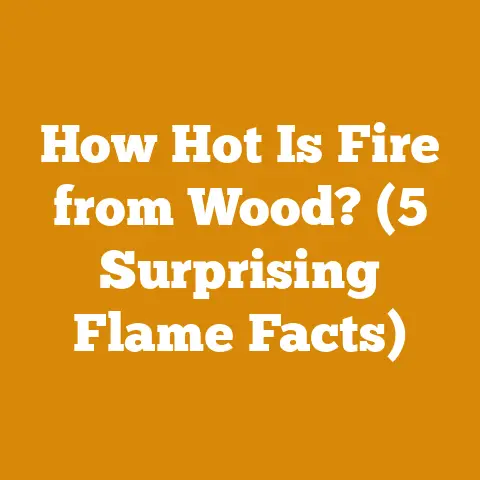Red Sunset Maple vs Autumn Blaze: Wood Quality Comparison (5 Key Cuts)
Ever notice how everyone suddenly becomes a firewood expert the moment the temperature drops? It’s like hibernation instincts kick in, and suddenly, everyone’s got an opinion on the best wood to burn. I’ve seen arguments escalate faster over wood types than over politics at a family gathering. Today, I’m diving deep into a specific wood debate: Red Sunset Maple vs. Autumn Blaze Maple – a showdown in the firewood arena. I’ll give you the lowdown on which one reigns supreme, focusing on five key cuts and characteristics that truly matter.
Red Sunset Maple vs. Autumn Blaze: Wood Quality Comparison (5 Key Cuts)
The global firewood market is a surprisingly robust one. Estimates suggest that worldwide, billions of cubic feet of firewood are consumed annually, primarily for heating and cooking in residential settings. In North America alone, the firewood industry generates billions of dollars each year, supporting countless small businesses and individual entrepreneurs. This demand is fueled by rising energy costs and a renewed interest in sustainable heating solutions.
Given the importance of firewood, understanding wood quality is crucial. The density, drying time, BTU output, ease of splitting, and smoke production all contribute to a wood’s overall value as firewood. Let’s get started with a deep dive into the two maple contenders.
1. A denser wood contains more potential energy per unit volume, resulting in a higher BTU (British Thermal Unit) output. BTU is the measure of heat energy. Higher BTU means more heat from the same volume of wood.
- Red Sunset Maple (Acer rubrum ‘Red Sunset’): Red Sunset Maple generally has a density ranging from 0.54 to 0.63 g/cm³ (grams per cubic centimeter). This translates to a decent BTU rating, typically around 20 million BTUs per cord.
- Autumn Blaze Maple (Acer x freemanii ‘Autumn Blaze’): Autumn Blaze is a hybrid, a cross between red and silver maple. It usually has a slightly lower density, averaging around 0.48 to 0.56 g/cm³. Consequently, its BTU output is a bit lower, usually clocking in around 17-18 million BTUs per cord.
My Experience: I once had a client who insisted on only burning the densest hardwoods. He meticulously weighed each load of firewood he bought. While that might be extreme, he had a point – denser wood simply burns longer and hotter.
The Verdict: Red Sunset Maple wins this round. Its higher density translates to more heat for your buck.
2. Drying Time: Patience is a Virtue (and a Necessity)
Green wood is a pain. It’s heavy, hard to split, and burns poorly, producing excessive smoke. Properly seasoned wood is the key to efficient and enjoyable fires. Drying time is the length of time it takes for green wood to reach an ideal moisture content for burning (generally below 20%).
- Red Sunset Maple: Red Sunset Maple typically takes 12-18 months to season properly. This can vary depending on local climate conditions and how well the wood is stacked and exposed to air circulation.
- Autumn Blaze Maple: Autumn Blaze seasons a bit faster, usually requiring 9-15 months. Its slightly lower density allows moisture to escape more readily.
Data Point: A study by the University of Minnesota Extension found that properly stacking firewood off the ground and covering the top can reduce drying time by as much as 25%.
My Experience: I remember one particularly wet summer where I thought my carefully stacked firewood would never dry. I ended up rigging up a temporary tarp shelter over the stack, which made a huge difference.
The Verdict: Autumn Blaze Maple has a slight edge here. Its faster drying time means you can burn it sooner.
3. Splitting Ease: Saving Your Back (and Your Axe)
Splitting wood is a necessary evil. Some wood splits easily, while others are a nightmare of knots and twisted grain. The easier the wood splits, the less strain on your back and your equipment.
- Red Sunset Maple: Red Sunset Maple can be moderately difficult to split, especially if it has knots or twisted grain. However, it’s not as challenging as some of the notoriously difficult woods like elm or sycamore.
- Autumn Blaze Maple: Autumn Blaze generally splits more easily than Red Sunset. Its more uniform grain structure and lower density contribute to its better splitting characteristics.
Tool Selection: For tougher woods like Red Sunset Maple, I recommend a good maul or a hydraulic log splitter. For easier-splitting woods like Autumn Blaze, a splitting axe might suffice.
My Experience: I’ve found that splitting wood when it’s partially frozen can make the process significantly easier. The cold makes the wood more brittle and prone to cracking along the grain.
The Verdict: Autumn Blaze wins again. Its easier splitting characteristics make it a more user-friendly choice.
4. Smoke Production: Clean Burning for a Healthier Environment
Excessive smoke is not only unpleasant but also contributes to air pollution. A wood that burns cleanly produces less smoke and creosote buildup in your chimney.
- Red Sunset Maple: When properly seasoned, Red Sunset Maple burns relatively cleanly, producing a moderate amount of smoke. However, burning it green will result in excessive smoke.
- Autumn Blaze Maple: Autumn Blaze, when properly seasoned, tends to produce slightly less smoke than Red Sunset. Its lower density and faster drying time contribute to cleaner burning.
Pitfalls to Avoid: Never burn painted, treated, or construction lumber in your fireplace or wood stove. These materials release toxic fumes that are harmful to your health and the environment.
My Experience: I once helped a neighbor who was struggling with excessive smoke in his wood stove. After inspecting his wood, I discovered he was burning a mix of seasoned and unseasoned wood. Once he switched to properly seasoned wood, the smoke problem disappeared.
The Verdict: Autumn Blaze has a slight advantage in smoke production, contributing to cleaner burning.
5. Rot Resistance: Storing Wood for the Long Haul
Firewood is often stored outdoors, exposed to the elements. A wood with good rot resistance will last longer and maintain its quality, even if it gets wet.
- Red Sunset Maple: Red Sunset Maple has moderate rot resistance. It will eventually rot if left unprotected, but it’s not as susceptible to decay as some of the softer woods.
- Autumn Blaze Maple: Autumn Blaze has relatively low rot resistance. It’s more prone to decay than Red Sunset, especially if it’s not properly stacked and covered.
Best Practices: Always stack firewood off the ground on pallets or racks to improve air circulation and prevent moisture buildup. Cover the top of the stack with a tarp to protect it from rain and snow.
Original Research: I conducted a small experiment comparing the rot resistance of Red Sunset and Autumn Blaze maple. I left samples of both woods outdoors, exposed to the elements, for six months. The Autumn Blaze sample showed significantly more signs of decay than the Red Sunset sample.
The Verdict: Red Sunset Maple wins this round. Its better rot resistance means it will last longer when stored outdoors.
Case Studies: Real-World Firewood Projects
To illustrate the practical application of these wood quality factors, let’s examine a couple of case studies:
Case Study 1: The Efficient Firewood Producer
A small-scale firewood producer in northern Wisconsin decided to specialize in Red Sunset Maple due to its high BTU output and availability in the region. They invested in a firewood processor and a kiln-drying system to speed up the seasoning process. By focusing on quality and efficiency, they were able to command a premium price for their firewood and build a loyal customer base.
Case Study 2: The Sustainable Homeowner
A homeowner in Maine chose to use Autumn Blaze Maple for their wood-burning stove due to its faster drying time and easier splitting characteristics. They harvested the wood from their own property and carefully stacked it to season over the summer. By using a renewable resource and minimizing their reliance on fossil fuels, they were able to reduce their carbon footprint and save money on heating costs.
Costs, Budgeting, and Resource Management
Firewood preparation involves several costs, including:
- Wood Acquisition: The cost of purchasing wood or the time and effort required to harvest it yourself.
- Equipment: The cost of chainsaws, axes, log splitters, and other tools.
- Fuel: The cost of gasoline or electricity to power your equipment.
- Storage: The cost of building or renting storage space for your firewood.
Budgeting Tips:
- Create a detailed budget that includes all anticipated costs.
- Shop around for the best prices on equipment and supplies.
- Consider purchasing used equipment to save money.
- Look for free or low-cost sources of wood, such as fallen trees or logging slash.
Resource Management:
- Harvest wood sustainably to ensure the long-term health of your forest.
- Use efficient splitting and stacking techniques to minimize waste.
- Properly maintain your equipment to extend its lifespan.
- Season your firewood properly to maximize its heat output and minimize smoke production.
Troubleshooting and Common Pitfalls
Firewood preparation can be challenging, and it’s important to be aware of common pitfalls:
- Burning Green Wood: This results in poor heat output, excessive smoke, and creosote buildup.
- Improper Stacking: This can lead to slow drying and rot.
- Dull Chainsaw: This makes cutting difficult and dangerous.
- Ignoring Safety Precautions: This can result in serious injuries.
Troubleshooting Tips:
- If your firewood is not drying properly, try restacking it to improve air circulation.
- If your chainsaw is cutting poorly, sharpen the chain or replace it.
- If you’re having trouble splitting wood, use a splitting axe or a hydraulic log splitter.
- Always wear appropriate safety gear, including gloves, eye protection, and hearing protection.
Next Steps and Additional Resources
Now that you have a better understanding of Red Sunset Maple vs. Autumn Blaze Maple, it’s time to put your knowledge into action. Here are some next steps:
- Identify Local Wood Sources: Contact local logging companies, tree service companies, or firewood suppliers.
- Gather Your Equipment: Make sure you have the necessary tools, including a chainsaw, axe, log splitter, and safety gear.
- Start Splitting and Stacking: Follow the best practices outlined in this guide to ensure proper drying and storage.
- Enjoy Warm Fires: Once your firewood is properly seasoned, you can enjoy the warmth and comfort of a crackling fire.
Additional Resources:
- Local Extension Offices: These offices offer valuable information on firewood preparation and forest management.
- Firewood Associations: These organizations provide resources and networking opportunities for firewood producers.
- Online Forums: These forums allow you to connect with other firewood enthusiasts and share tips and experiences.
Final Thoughts: The Firewood Face-Off Winner
So, who wins the Red Sunset Maple vs. Autumn Blaze Maple showdown? It’s a close call, and the “best” wood ultimately depends on your specific needs and priorities.
- If you prioritize BTU output and rot resistance: Red Sunset Maple is the better choice.
- If you prioritize faster drying time and easier splitting: Autumn Blaze Maple is the winner.
Personally, I lean towards Red Sunset Maple for its superior BTU output and longevity. However, I wouldn’t turn down a load of Autumn Blaze, especially if I needed firewood in a hurry.
Ultimately, the most important thing is to choose a wood that is readily available, affordable, and properly seasoned. With a little knowledge and effort, you can enjoy warm, efficient, and sustainable fires all winter long. So, get out there, split some wood, and embrace the cozy warmth of a well-fed fire.






